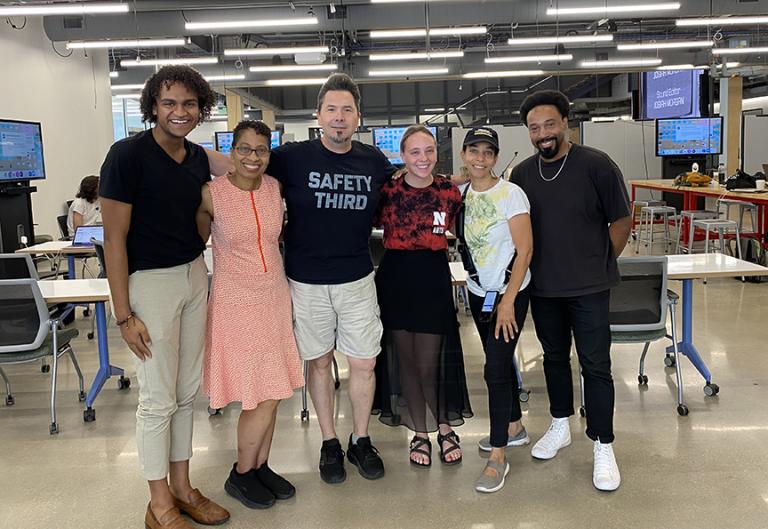
Carson Center, Black Public Media launch emerging media residency program
calendar icon24 Aug 2022
Lincoln, Neb.--The Johnny Carson Center for Emerging Media Arts and Black Public Media (BPM) announced the first cohort of their new residency program, called the Black Public Media Residency at the Carson Center. The recipients, who are all developing creative technology projects, are artist Johannes Barfield, of Albuquerque, New Mexico; educator Rae Phillips, of Shreveport, Louisiana; and artist Andrea Walls, of Philadelphia, Pennsylvania.
Megan Elliott, founding director of the Carson Center, and Lisa Osborne, director of emerging media at BPM, initially designed the residency to offer access to specialized equipment, studio facilities and workspace, which can all be expensive to access for independent creatives. After reviewing all the applications, they decided to add a fourth component to the program—formal instruction. The two-week experience on UNL’s campus focused on skills development, watching augmented and virtual reality experiences from 2015 to present, discussing and analyzing those pieces and working independently.
Elliott recruited Assistant Professor of Emerging Media Arts Dan Novy to teach the artists Unity, Blender and Lens Studio and brought recent graduate Kayla LaPoure and fourth-year student Ebben Blake on board as teaching assistants. LaPoure helped the artists with Unity, while Blake taught them motion capture and LiDAR capture. Aja Evans, an immersive producer with Black Public Media, helped design and manage the residency program. Her responsibilities included reviewing applications, contributing titles to the AR/VR watchlist and advising artists about their individual projects.
“The first year of the residency program has truly exceeded all of our expectations,” Elliott said. “We recently saw the progress of the three artists on their projects at the end of the two-week period, and it was so fulfilling to see their progress and their success in utilizing new technology. We are thrilled to be a part of expanding the access to emerging technologies through these Black Public Media residencies.”
Barfield, who is a postdoctoral scholar at the University of New Mexico, is developing “Ancestral Plane,” a third-person, action-adventure video game about a former archeologist who returns looted artifacts to the communities from which they originated. Barfield is aiming for the more indie, arthouse side of the gaming spectrum.
Phillips is already in production on “School Sagas” (schoolsagas.com), an oral history project that features interviews of students from formerly segregated schools and exposes continuing disparities in the U.S. education system, including modern-day resegregation via elite magnet programs and extracurricular fees. The project currently includes a traveling exhibition and a documentary. The project has received support from the National Park Service, National Endowment for the Humanities, the Bishop Blue Foundation and Red River Radio.
Walls, a conceptual artist and poet, is curator of the Museum of Black Joy (museumofblackjoy.com), an archive and hybrid exhibition space “of non-traumatic Black life In Philadelphia and beyond, utilizing traditional storytelling and emerging tech to acknowledge and advance experiences rooted in Black joy.” The site features her street photography and video collages.
The Carson Center and BPM designed this residency to serve Black filmmakers, artists and creative technologists—given the well-documented, low numbers of Black filmmakers, executives, and artists working in the tech industry and the high cost to acquire specialized equipment, such as motion capture rigs, professional 360 cameras, and VR headsets, and training on emerging-tech equipment and software.
In addition to one to three weeks on site at the Carson Center, the residency provides a $5,000 to $10,000 grant from Black Public Media to develop their projects further. The residency was funded by the National Endowment for the Arts.
"We kept saying that this summer’s program would be our alpha test, and it has surpassed every expectation that we had. Megan and her team at Carson Center have been so welcoming and so collaborative,” Osborne said. “They are pros. They have created modules out of thin air, based on feedback and requests from the artists. It’s been a fantastic experience all around, and I look forward to returning next year. I can’t wait to see what kind of applications we get in 2023.”
Founded in 1979, Black Public Media supports the development of visionary content creators and distributes stories about the global Black experience to inspire a more equitable and inclusive future. The nonprofit, which is primarily funded by Corporation for Public Broadcasting, provides quality content for public media outlets, including PBS, PBS.org, and BlackPublicMedia.org, while training and mentoring the next generation of Black filmmakers. Its emerging media program, BPMplus, is funded by MacArthur Foundation, private gifts and other funders.